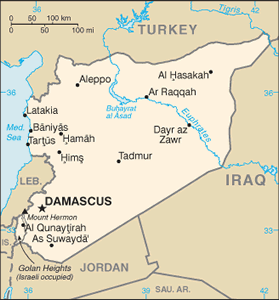The Geography of Syria
The Geography of Syria
Syrian Geography
Location: Middle East, bordering the Mediterranean Sea, between Lebanon and Turkey
Geographic coordinates: 35 00 N, 38 00 E
Map references: Middle East
Area: total: 185,180 sq km land: 184,050 sq km water: 1,130 sq km note: includes 1,295 sq km of Israeli-occupied territory
Area - comparative: slightly larger than North Dakota
Land boundaries: total: 2,253 km border countries: Iraq 605 km, Israel 76 km, Jordan 375 km, Lebanon 375 km, Turkey 822 km
Coastline: 193 km
Maritime claims: territorial sea: 12 nm contiguous zone: 24 nm
Climate: mostly desert; hot, dry, sunny summers (June to August) and mild, rainy winters (December to February) along coast; cold weather with snow or sleet periodically in Damascus
Terrain: primarily semiarid and desert plateau; narrow coastal plain; mountains in west
Elevation extremes: lowest point: unnamed location near Lake Tiberias -200 m highest point: Mount Hermon 2,814 m
Natural resources: petroleum, phosphates, chrome and manganese ores, asphalt, iron ore, rock salt, marble, gypsum, hydropower
Land use: arable land: 24.8% permanent crops: 4.47% other: 70.73% (2005)
Irrigated land: 13,330 sq km (2003)
Natural hazards: dust storms, sandstorms
Environment - current issues: deforestation; overgrazing; soil erosion; desertification; water pollution from raw sewage and petroleum refining wastes; inadequate potable water
Environment - international agreements: party to: Biodiversity, Climate Change, Climate Change-Kyoto Protocol, Desertification, Endangered Species, Hazardous Wastes, Ozone Layer Protection, Ship Pollution, Wetlands signed, but not ratified: Environmental Modification
Geography - note: there are 42 Israeli settlements and civilian land use sites in the Israeli-occupied Golan Heights (August 2005 est.)


